The cold chain logistics transport insulated truck market is projected to grow from USD 6.8 billion in 2025 to USD 12.9 billion by 2035, reflecting robust expansion with a forecast CAGR of 6.9%. This growth is largely driven by the increasing demand for advanced refrigerated transport technologies and substantial investments in cold chain infrastructure. Key sectors, including food distribution, pharmaceutical logistics, and temperature-sensitive cargo management, are central to this market expansion. As health-conscious consumers and regulatory bodies place greater emphasis on safety, the demand for reliable, temperature-controlled transportation continues to rise. In particular, the pharmaceutical sector’s need for precise, validated cold chain logistics solutions is expected to be a significant market driver.
The market is operating in a dynamic environment shaped by expanding demand for temperature-sensitive transportation solutions across multiple industries. Companies are increasingly looking to improve operational efficiency through multi-temperature transport systems that combine refrigeration precision with the capacity to optimize cargo load. Food distribution companies are under pressure to maintain strict temperature control throughout the entire supply chain, from farms to consumers. For pharmaceutical logistics providers, reliability and precise temperature maintenance are paramount, particularly in the transportation of vaccines, biopharmaceuticals, and other sensitive medical products. The flexibility of modern cold chain solutions, which can handle varying temperature requirements and cargo specifications, makes them critical in today's diverse global supply network.
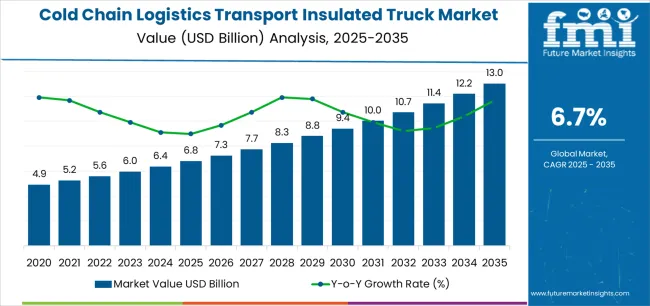
Technological innovations are central to this market's growth. The integration of IoT-based monitoring systems, GPS tracking capabilities, and enhanced insulation features are revolutionizing cold chain logistics. These innovations allow for real-time tracking and provide temperature validation throughout the entire transportation process, which is crucial for ensuring product integrity. By automating and digitizing temperature monitoring, cold chain logistics providers can reduce risks and ensure regulatory compliance, particularly for high-value, temperature-sensitive goods. Manufacturers are focusing on designing transport solutions that accommodate a range of temperature zones and are compatible with varying cargo volumes.
The cold chain logistics transport insulated truck market will experience two distinct phases of growth over the next decade. From 2025 to 2030, the market will grow from USD 6.8 billion to approximately USD 8.5 billion, adding USD 1.7 billion, representing 27% of the total forecasted growth. During this phase, the rapid adoption of IoT-based monitoring systems and the demand for real-time temperature tracking across distribution channels will be key drivers. The latter phase, from 2030 to 2035, will see accelerated growth, with the market expanding by USD 4.5 billion, representing 73% of the total market expansion. This phase will be characterized by widespread adoption of automated refrigeration technologies and seamless integration with fleet management systems, ensuring efficient operations across a range of temperature-controlled logistics networks.
| Period | Primary Revenue Buckets | Share | Notes |
|---|---|---|---|
| Today | 2.5-10 tons capacity trucks (food distribution) | 52% | Standard configurations, established routes |
| Above 10 tons systems | 31% | Long-haul transportation, bulk cargo | |
| Below 2.5 tons systems | 17% | Urban delivery, specialized applications | |
| Future (3-5 yrs) | Advanced 2.5-10 tons systems | 48-51% | Enhanced efficiency, digital controls |
| High-capacity above 10 tons systems | 33-36% | Interstate commerce, pharmaceutical distribution | |
| Food and dairy applications | 28-32% | Fresh produce, dairy distribution | |
| Pharmaceutical applications | 22-26% | Vaccine delivery, medical supplies | |
| Vegetables and fruits applications | 18-22% | Agricultural distribution, export logistics | |
| Specialized urban delivery | 15-19% | Last-mile delivery, e-commerce fulfillment | |
| Custom refrigeration systems | 8-12% | Multi-temperature, specialized cargo |
| Metric | Value |
|---|---|
| Market Value (2025) | USD 6.8 billion |
| Market Forecast (2035) | USD 6.8 billion |
| Growth Rate | 6.7% CAGR |
| Leading Type | Loading Capacity 2.5 Tons to 10 Tons |
| Primary Application → | Food and Dairy Products Segment |
The market demonstrates strong fundamentals with mid-capacity truck systems capturing dominant share through advanced refrigeration control and logistics application optimization. Food and dairy applications drive primary demand, supported by increasing international trade activity and cold chain facility expansion initiatives. Geographic distribution remains concentrated in developed markets with established logistics infrastructure, while emerging economies show accelerating adoption rates driven by supply chain modernization programs and rising cold storage investment.
Primary Classification: The market segments by loading capacity into below 2.5 tons, 2.5 tons to 10 tons, and above 10 tons systems, representing evolution from urban delivery to comprehensive temperature-controlled freight transportation for supply chain logistics optimization.
Secondary Classification: Application segmentation divides the market into food and dairy products, vegetables and fruits, vaccines and medicines, and others, reflecting distinct requirements for temperature ranges, cargo handling specifications, and distribution protocol requirements.
Tertiary Classification: End-use segmentation covers food distribution companies, pharmaceutical logistics providers, retail chains, agricultural exporters, and third-party logistics operators, while distribution channels span direct manufacturer sales, commercial vehicle dealers, and specialized logistics equipment suppliers.
Regional Classification: Geographic distribution covers North America, Latin America, Western Europe, Eastern Europe, East Asia, South Asia Pacific, and Middle East & Africa, with developed markets leading adoption while emerging economies show accelerating growth patterns driven by cold chain infrastructure development programs.
The segmentation structure reveals technology progression from traditional refrigerated transport toward sophisticated multi-temperature systems with enhanced monitoring capabilities, while application diversity spans from local food distribution to specialized pharmaceutical logistics requiring precise temperature control solutions.
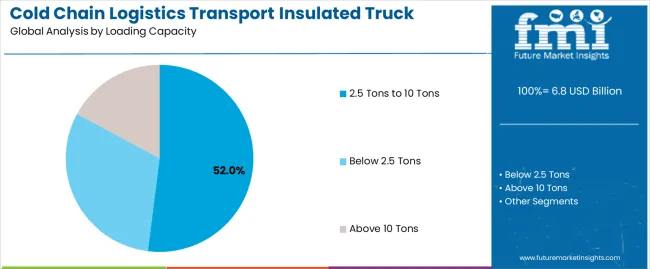
Market Position: Mid-capacity insulated truck systems command the leading position in the cold chain logistics transport market with 52% market share through proven refrigeration technologies, including efficient cooling systems, reliable insulation mechanisms, and logistics performance optimization that enable distribution operators to achieve optimal cargo conditions across diverse food distribution and pharmaceutical delivery environments.
Value Drivers: The segment benefits from logistics company preference for versatile transport systems that provide consistent temperature control, operational reliability, and cargo flexibility without requiring specialized licensing requirements. Advanced mid-capacity processing features enable enhanced temperature uniformity, precise cooling control, and integration with existing fleet management systems, where cargo preservation and route efficiency represent critical operational requirements.
Competitive Advantages: Mid-capacity insulated truck systems differentiate through proven operational reliability, licensing compatibility, and integration with established logistics management systems that enhance distribution effectiveness while maintaining optimal temperature standards suitable for diverse cargo applications.
Key market characteristics:
Above 10 tons insulated truck systems maintain a 31% market position in the cold chain logistics transport market due to their high-capacity configuration advantages and long-haul application benefits. These systems appeal to operators requiring bulk transportation solutions with enhanced cargo volume profiles for interstate distribution operations. Market growth is driven by pharmaceutical logistics expansion, emphasizing high-volume transport solutions and operational excellence through optimized cargo handling designs.
Below 2.5 tons insulated truck systems capture 17% market share through urban delivery requirements and last-mile distribution applications. These vehicles provide specialized solutions for city logistics, e-commerce fulfillment, and small-batch pharmaceutical delivery where maneuverability and access restrictions limit larger vehicle deployment.
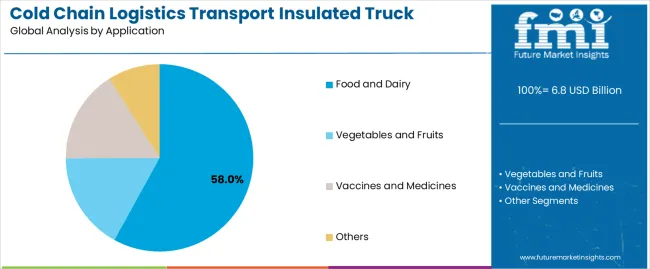
Market Context: Food and dairy applications demonstrate strong growth in the cold chain logistics transport market, accounting for 58% of the market, due to the widespread adoption of fresh food distribution technologies and an increasing focus on dairy product logistics, frozen food transportation, and perishable goods delivery that maximize distribution effectiveness while maintaining food safety integrity standards.
Appeal Factors: Food distribution companies prioritize system reliability, temperature precision, and integration with existing logistics infrastructure that enables coordinated distribution procedures across multiple delivery protocols. The segment benefits from substantial food trade investment and agricultural export programs that emphasize acquisition of advanced refrigerated transport systems for fresh produce optimization and dairy product applications.
Growth Drivers: Agricultural export programs incorporate insulated trucks as essential components for fresh produce operations, while food retail expansion increases demand for refrigerated transport capabilities that comply with food safety standards and minimize product spoilage.
Market Challenges: Varying food safety protocols and cargo size complexity may limit system standardization across different distribution facilities or delivery scenarios.
Application dynamics include:
Vegetables and fruits applications capture 24% market share through agricultural export requirements in produce distribution centers, farming cooperatives, and international trade applications. These facilities demand high-performance refrigerated transport systems capable of supporting agricultural protocols while providing temperature precision and cargo preservation capabilities.
Vaccines and medicines applications account for 18% market share, including pharmaceutical distribution, medical supply chains, and healthcare logistics operations requiring precise refrigerated transport capabilities for temperature-sensitive medical products and pharmaceutical cold chain optimization.
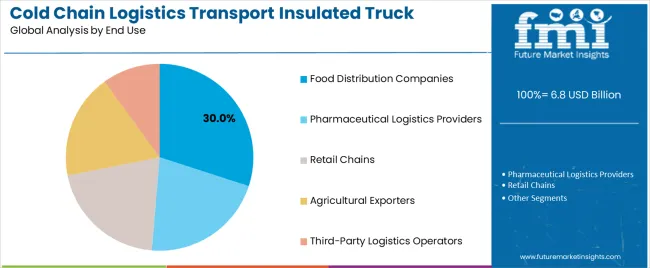
Market Context: Food Distribution Companies dominate the market with a 30% share, reflecting the primary demand source for cold chain logistics transport technology in food supply chain and distribution optimization.
Business Model Advantages: Food Distribution Companies provide direct market demand for standardized refrigerated transport systems, driving volume production and cost optimization while maintaining temperature control and performance consistency requirements.
Operational Benefits: Food Distribution Company applications include supply chain optimization, distribution efficiency, and cargo preservation that drive consistent demand for refrigerated transport systems while providing access to latest cold chain technologies.
| Category | Factor | Impact | Why It Matters |
|---|---|---|---|
| Driver | E-commerce expansion & online grocery growth (fresh food delivery, pharmaceutical distribution) | ★★★★★ | Growing online market requires advanced refrigerated transport systems with enhanced temperature control capabilities and tracking properties proven effective across logistics applications. |
| Driver | Food safety regulations & pharmaceutical cold chain compliance (FDA requirements, international standards) | ★★★★★ | Transforms logistics requirements from "basic refrigeration" to "validated temperature control"; operators that offer certified transport systems and monitoring features gain competitive advantage. |
| Driver | International trade growth & agricultural exports (fresh produce, dairy products) | ★★★★☆ | Global food trade needs sophisticated, certified refrigerated transport systems; demand for temperature-controlled and monitored logistics solutions expanding addressable market. |
| Restraint | High vehicle cost & fleet investment requirements (especially for smaller logistics companies) | ★★★★☆ | Smaller logistics operators defer refrigerated fleet upgrades; increases price sensitivity and slows advanced equipment adoption in cost-conscious markets. |
| Restraint | Alternative cold chain solutions (rail refrigeration, air cargo, cold storage facilities) | ★★★☆☆ | Alternative logistics methods offer established supply chains and different cost structures, potentially limiting refrigerated truck adoption in specific transport corridors. |
| Trend | IoT integration & real-time monitoring (smart tracking, temperature alerts) | ★★★★★ | Advanced monitoring properties, cargo optimization, and data analytics transform operations; technology integration and performance enhancement become core value propositions. |
| Trend | Fleet electrification & environmental compliance (electric refrigerated vehicles, emission standards) | ★★★★☆ | Electric cold chain vehicles for urban applications and specific routes; specialized emission reduction and targeted efficiency capabilities drive competition toward electric solutions. |
The cold chain logistics transport insulated truck market demonstrates varied regional dynamics with Growth Leaders including China (9.0% growth rate) and India (8.4% growth rate) driving expansion through logistics infrastructure development and supply chain modernization initiatives. Steady Performers encompass Germany (7.7% growth rate), Brazil (7.0% growth rate), and developed regions, benefiting from established cold chain networks and food distribution sector growth. Mature Markets feature United States (6.4% growth rate), United Kingdom (5.7% growth rate), and Japan (5.0% growth rate), where logistics advancement and cold chain optimization requirements support consistent growth patterns.
Regional synthesis reveals East Asian markets leading adoption through e-commerce expansion and food trade development, while North American countries maintain steady expansion supported by food safety regulations and agricultural infrastructure investment. European markets show strong growth driven by international trade applications and logistics integration trends.
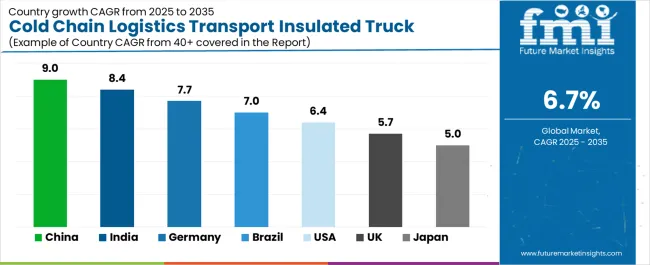
| Region/Country | 2025-2035 Growth | How to win | What to watch out |
|---|---|---|---|
| China | 9.0% | Focus on cost-effective logistics solutions | Regulatory changes; local competition |
| India | 8.4% | Lead with multi-temperature systems | Import restrictions; infrastructure barriers |
| Germany | 7.7% | Provide premium fleet systems | Over-regulation; lengthy approvals |
| Brazil | 7.0% | Offer value-oriented solutions | Currency fluctuations; import duties |
| United States | 6.4% | Push technology integration | Compliance costs; scaling challenges |
| United Kingdom | 5.7% | Focus on logistics applications | Economic impacts; fuel cost constraints |
| Japan | 5.0% | Emphasize precision manufacturing | Traditional preferences; adoption rates |
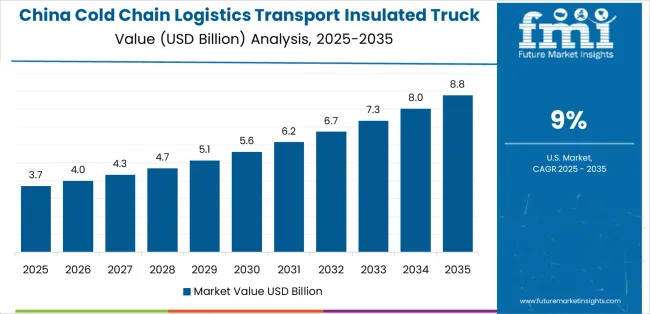
China establishes fastest market growth through aggressive e-commerce infrastructure development programs and comprehensive food distribution facility expansion, integrating advanced insulated truck systems as standard components in logistics networks and cold chain operations. The country's 9.0% growth rate reflects government initiatives promoting cold chain infrastructure and domestic food safety capabilities that mandate use of refrigerated transport systems in agricultural distribution and pharmaceutical delivery facilities. Growth concentrates in major logistics hubs, including Beijing, Shanghai, and Guangzhou, where supply chain development showcases integrated cold chain systems that appeal to distribution operators seeking temperature precision capabilities and cargo preservation applications.
Chinese manufacturers are developing cost-effective refrigerated transport solutions that combine domestic production advantages with advanced cooling features, including enhanced temperature control and improved efficiency capabilities. Distribution channels through commercial vehicle dealers and logistics equipment suppliers expand market access, while government support for food safety development supports adoption across diverse agricultural and pharmaceutical segments.
Strategic Market Indicators:
In Mumbai, Delhi, and Bangalore, food distribution facilities and logistics operators are implementing cold chain transport systems as standard equipment for supply chain optimization and cargo preservation applications, driven by increasing government agricultural investment and food safety development programs that emphasize importance of temperature-controlled logistics capabilities. The market holds a 8.4% growth rate, supported by government trade initiatives and agricultural modernization programs that promote advanced refrigerated transport systems for food distribution and pharmaceutical facilities. Indian operators are adopting refrigerated transport systems that provide consistent temperature precision and cargo preservation features, particularly appealing in urban regions where food safety optimization and distribution excellence represent critical logistics requirements.
Market expansion benefits from growing e-commerce capabilities and international technology partnerships that enable domestic production of advanced refrigerated transport systems for food and pharmaceutical applications. Technology adoption follows patterns established in logistics equipment, where temperature control and efficiency drive procurement decisions and operational deployment.
Market Intelligence Brief:
Advanced logistics market in Germany demonstrates sophisticated insulated truck deployment with documented temperature effectiveness in food distribution applications and pharmaceutical facilities through integration with existing cold chain systems and supply chain infrastructure. The country leverages engineering expertise in refrigeration technologies and logistics systems integration to maintain a 7.7% growth rate. Distribution centers, including Bavaria, Baden-Württemberg, and North Rhine-Westphalia, showcase premium installations where refrigerated transport systems integrate with comprehensive cold chain platforms and fleet management systems to optimize logistics efficiency and cargo preservation effectiveness.
German manufacturers prioritize system quality and EU compliance in cold chain development, creating demand for premium systems with advanced features, including fleet integration and temperature monitoring systems. The market benefits from established logistics infrastructure and willingness to invest in advanced refrigerated technologies that provide long-term operational benefits and compliance with international food safety standards.
Market Intelligence Brief:
Cold chain logistics transport insulated truck market expansion in Brazil benefits from diverse agricultural demand, including food export modernization in São Paulo and Rio de Janeiro, cold chain facility upgrades, and government trade programs that increasingly incorporate refrigerated transport solutions for distribution applications. The country maintains a 7.0% growth rate, driven by rising agricultural activity and increasing recognition of temperature control benefits, including accurate cargo preservation and enhanced distribution effectiveness.
Market dynamics focus on cost-effective refrigerated transport solutions that balance temperature performance with affordability considerations important to Brazilian logistics operators. Growing agricultural industrialization creates continued demand for modern refrigerated transport systems in new distribution infrastructure and supply chain modernization projects.
Strategic Market Considerations:
United States establishes market leadership through comprehensive food distribution programs and advanced cold chain infrastructure development, integrating insulated truck systems across food retail and pharmaceutical applications. The country's 6.4% growth rate reflects established logistics relationships and mature cold chain technology adoption that supports widespread use of refrigerated transport systems in food distribution and pharmaceutical facilities. Growth concentrates in major logistics centers, including California, Texas, and Illinois, where cold chain technology showcases mature deployment that appeals to distribution operators seeking proven temperature capabilities and cargo preservation applications.
American logistics providers leverage established distribution networks and comprehensive technical support capabilities, including fleet design programs and training support that create customer relationships and operational advantages. The market benefits from mature regulatory standards and food safety requirements that mandate refrigerated transport use while supporting technology advancement and supply chain optimization.
Market Intelligence Brief:
United Kingdom's logistics market demonstrates integrated insulated truck deployment with documented temperature effectiveness in food distribution applications and pharmaceutical facilities through integration with existing cold chain systems and supply chain infrastructure. The country maintains a 5.7% growth rate, supported by logistics efficiency programs and cargo preservation requirements that promote refrigerated transport systems for distribution applications. Logistics facilities across England, Scotland, and Wales showcase systematic installations where refrigerated transport systems integrate with comprehensive cold chain platforms to optimize temperature control and cargo preservation outcomes.
UK logistics providers prioritize system reliability and cold chain compatibility in transport procurement, creating demand for validated systems with proven temperature features, including performance monitoring integration and fleet management systems. The market benefits from established logistics infrastructure and quality requirements that support cold chain technology adoption and cargo preservation effectiveness.
Market Intelligence Brief:
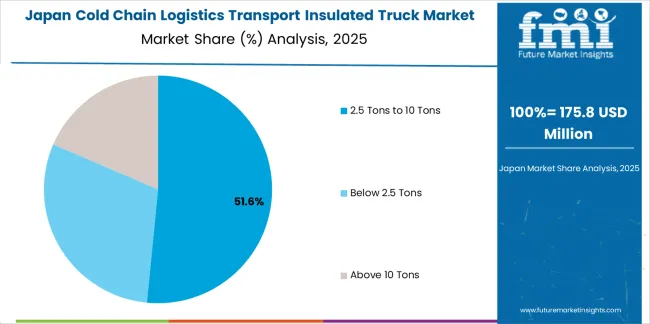
Japan's market growth benefits from precision logistics demand, including advanced food distribution facilities in Tokyo and Osaka, quality integration, and temperature enhancement programs that increasingly incorporate refrigerated transport solutions for distribution applications. The country maintains a 5.0% growth rate, driven by logistics technology advancement and increasing recognition of precision temperature control benefits, including accurate cargo preservation and enhanced distribution outcomes.
Market dynamics focus on high-precision refrigerated transport solutions that meet Japanese quality standards and temperature effectiveness requirements important to logistics operators. Advanced cold chain technology adoption creates continued demand for sophisticated refrigerated transport systems in logistics facility infrastructure and supply chain modernization projects.
Strategic Market Considerations:
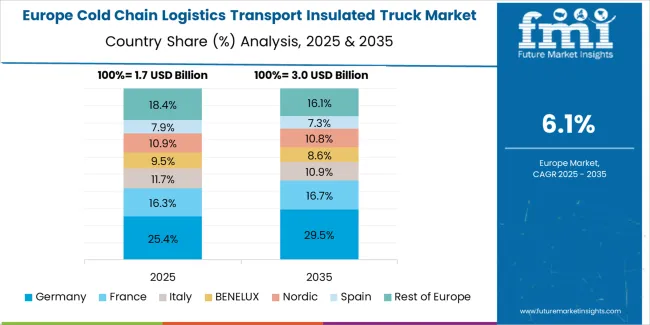
The European cold chain logistics transport insulated truck market is projected to grow from USD 1,286.8 million in 2025 to USD 1,958.4 million by 2035, registering a CAGR of 4.3% over the forecast period. Germany is expected to maintain its leadership position with a 38.7% market share in 2025, supported by its advanced logistics infrastructure and major food distribution centers.
United Kingdom follows with a 26.2% share in 2025, driven by comprehensive cold chain programs and pharmaceutical distribution initiatives. France holds a 17.4% share through specialized logistics applications and food safety compliance requirements. Italy commands a 9.8% share, while Spain accounts for 7.9% in 2025. The rest of Europe region is anticipated to gain momentum, expanding its collective share from 3.1% to 3.4% by 2035, attributed to increasing cold chain adoption in Nordic countries and emerging logistics facilities implementing supply chain modernization programs.
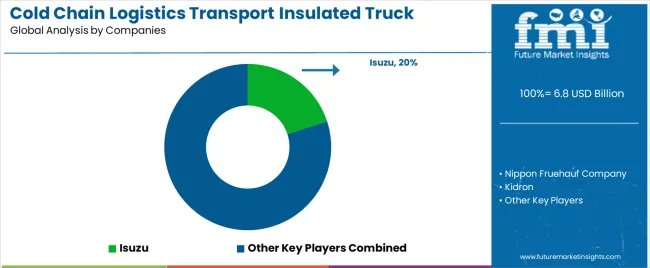
| Stakeholder | What they actually control | Typical strengths | Typical blind spots |
|---|---|---|---|
| Global brands | Distribution reach, broad product catalogs, brand recognition | Wide availability, proven reliability, multi-region support | Product refresh cycles; customer dependency on brand validation |
| Technology innovators | Refrigeration R&D; advanced cooling technologies; enhanced monitoring properties | Latest technologies first; attractive ROI on temperature effectiveness | Service density outside core regions; scaling complexity |
| Regional specialists | Local compliance, fast delivery, nearby customer support | "Close to customer" support; pragmatic pricing; local regulations | Technology gaps; talent retention in customer service |
| Full-service providers | Complete cold chain programs, fleet integration, performance monitoring | Lowest operational risk; comprehensive support | Service costs if overpromised; technology obsolescence |
| Niche specialists | Specialized applications, custom systems, logistics services | Win premium applications; flexible configurations | Scalability limitations; narrow market focus |
| Item | Value |
|---|---|
| Quantitative Units | USD 6.8 billion |
| Loading Capacity | Below 2.5 Tons, 2.5 Tons to 10 Tons, Above 10 Tons |
| Application | Food and Dairy Products, Vegetables and Fruits, Vaccines and Medicines, Others |
| End Use | Food Distribution Companies, Pharmaceutical Logistics Providers, Retail Chains, Agricultural Exporters, Third-Party Logistics Operators |
| Regions Covered | North America, Latin America, Western Europe, Eastern Europe, East Asia, South Asia Pacific, Middle East & Africa |
| Countries Covered | China, India, Germany, Brazil, United States, United Kingdom, Japan, Canada, France, Australia, and 25+ additional countries |
| Key Companies Profiled | Isuzu, Nippon Fruehauf Company, Kidron, Morgan Truck Body, Schmitz Cargobull, Hyundai, Wuling Motors, FAW Jiefang Automotive, BAIC Foton Motor |
| Additional Attributes | Dollar sales by loading capacity and application categories, regional adoption trends across East Asia, North America, and Western Europe, competitive landscape with commercial vehicle manufacturers and fleet integrators, logistics operator preferences for temperature effectiveness and cargo preservation, integration with fleet management platforms and tracking systems, innovations in refrigeration technology and temperature enhancement, and development of advanced cold chain solutions with enhanced performance and supply chain optimization capabilities. |
The global cold chain logistics transport insulated truck market is estimated to be valued at USD 6.8 billion in 2025.
The market size for the cold chain logistics transport insulated truck market is projected to reach USD 13.0 billion by 2035.
The cold chain logistics transport insulated truck market is expected to grow at a 6.7% CAGR between 2025 and 2035.
The key product types in cold chain logistics transport insulated truck market are 2.5 tons to 10 tons , below 2.5 tons and above 10 tons.
In terms of application, food and dairy segment to command 58.0% share in the cold chain logistics transport insulated truck market in 2025.






Full Research Suite comprises of:
Market outlook & trends analysis
Interviews & case studies
Strategic recommendations
Vendor profiles & capabilities analysis
5-year forecasts
8 regions and 60+ country-level data splits
Market segment data splits
12 months of continuous data updates
DELIVERED AS:
PDF EXCEL ONLINE
Cold Forging Machine Market Size and Share Forecast Outlook 2025 to 2035
Cold-Pressed Oil Market Size and Share Forecast Outlook 2025 to 2035
Cold Plates Market Size and Share Forecast Outlook 2025 to 2035
Cold-Pressed Fruit Extracts Market Size and Share Forecast Outlook 2025 to 2035
Cold Heading Wire Market Size and Share Forecast Outlook 2025 to 2035
Cold Water Swelling Starch Market Analysis - Size, Share, and Forecast Outlook 2025 to 2035
Cold Insulation Materials Market Size and Share Forecast Outlook 2025 to 2035
Cold Finished Iron and Steel Bars and Bar Size Shapes Market Size and Share Forecast Outlook 2025 to 2035
Cold Storage Equipment Market Size and Share Forecast Outlook 2025 to 2035
Cold Laser Therapy Market Analysis - Size, Share & Forecast 2025 to 2035
Cold Mix Asphalt Market Size and Share Forecast Outlook 2025 to 2035
Cold Cuts Market Analysis - Size, Share, and Forecast 2025 to 2035
Cold Seal Paper Market Size and Share Forecast Outlook 2025 to 2035
Cold Pain Therapy Market Size and Share Forecast Outlook 2025 to 2035
Cold Formed Blister Foil Market Growth - Demand & Forecast 2025 to 2035
Cold Waxed Paper Cups Market Size and Share Forecast Outlook 2025 to 2035
Cold Form Foil Market Analysis by Aluminum, Plastic Film, and Others Through 2025 to 2035
Cold Seal Plastic Films Market Size and Share Forecast Outlook 2025 to 2035
Cold Packs Market Analysis - Size, Share, & Forecast Outlook 2025 to 2035
Cold Insulation Market Growth - Trends & Forecast 2025 to 2035

Thank you!
You will receive an email from our Business Development Manager. Please be sure to check your SPAM/JUNK folder too.
Chat With
MaRIA